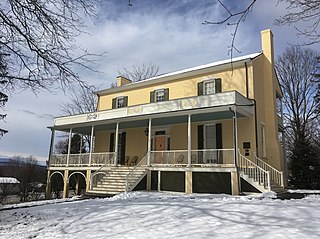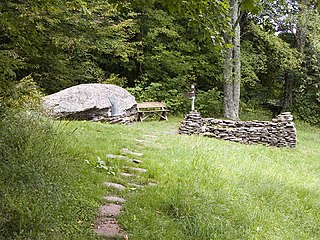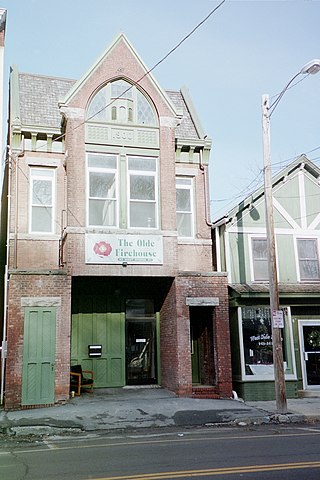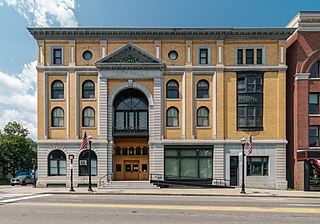
Greenport is a town in Columbia County, New York, United States. The population was 4,165 at the 2010 census. The town is on the western border of the county and surrounds the city of Hudson on three sides. US 9 passes through the town.

Oneonta is a city in southern Otsego County, New York, United States. It is one of the northernmost cities of Appalachia. Oneonta is home to the State University of New York at Oneonta and Hartwick College. SUNY Oneonta began as a normal school and a teacher's college in 1889, and Hartwick College moved into the city in 1928. The approximately 5,800 students from SUNY Oneonta and the approximately 1,500 students at Hartwick make up a significant percentage of the population of Oneonta. According to the 2020 U.S. Census, Oneonta had a population of 13,079. Its nickname is "City of the Hills." While the word "oneonta" is of undetermined origin, it is popularly believed to mean "place of open rocks" in the Mohawk language. This refers to a prominent geological formation known as "Table Rock" at the western end of the city.

Woodbridge is a historic neighborhood of primarily Victorian homes located in Detroit, Michigan. The district was listed on the National Register of Historic Places in 1980, with later boundary increases in 1997 and 2008. In addition to its historic value, Woodbridge is also notable for being an intact neighborhood of turn-of-the-century homes within walking or biking distance of Detroit's Downtown, Midtown, New Center, and Corktown neighborhoods.

Loch Sheldrake is a hamlet and census-designated place (CDP) in the Town of Fallsburg, New York, United States, in Sullivan County. The zip code for Loch Sheldrake is 12759.

The Thomas Cole National Historic Site, also known as Cedar Grove, is a National Historic Landmark that includes the home and the studio of painter Thomas Cole, founder of the Hudson River School of American painting. It is located at 218 Spring Street, Catskill, NY, United States. The site provided Thomas Cole with a residence and studio from 1833 through his death in 1848.

Woodchuck Lodge is a historic house on Burroughs Memorial Road in a remote part of the western Catskills in Roxbury, New York. Built in the mid-19th century, it was the last home of naturalist and writer John Burroughs (1837-1921) from 1908, and is the place of his burial. The property is now managed by the state of New York as the John Burroughs Memorial State Historic Site, and the house is open for tours on weekends between May and October. The property is a National Historic Landmark, designated in 1962 for its association with Burroughs, one of the most important nature writers of the late 19th and early 20th centuries.

The Wiley Hose Company Building is located in Catskill, New York. The three story, brick building is a representative example of a turn-of-the-century firehouse. It was built in 1900 by George W. Holdridge, a local builder. The brick was produced in the Catskill area, and is complemented by stone and terra cotta detailing. The firehouse was altered somewhat around 1930 to accommodate the newer, larger mechanized fire equipment that replaced horse-drawn and smaller mechanized equipment. The matching entry porticos on either side were added at this time, and the wooden flooring in the equipment bay was replaced with concrete.

Ulster Heights Synagogue, formally known as Congregation Knesset Israel of Ulster Heights, is located at the corner of Beaver Dam and Ulster Heights roads in the Ulster Heights section of the town of Wawarsing, New York, United States. It was built in 1924 by the early Jewish settlers of the southeastern Catskill region. In 2001 it was added to the National Register of Historic Places as a relatively intact example of a vernacular rural synagogue typical of the region.

The Rushmore Memorial Library, also known as the Rushmore Memorial Building, is located at the junction of NY 32 and Weygant Hill Road in Highland Mills, New York, United States. It is a small Arts and Crafts-style stone building constructed in the 1920s with a donation from Charles E. Rushmore, a local resident for whom Mount Rushmore is also named.

Church of St. John the Evangelist is an historic Episcopal church located in the village of Tannersville, part of the town of Hunter in Greene County, New York. It was built in 1885 and is a one-story, one-by-six bay structure. It is built of light frame construction atop partial fieldstone walls on a fieldstone foundation. It features a steeply pitched gable roof with a large square belfry on the ridge. It was designed by architect William Halsey Wood (1855–1897).

Prairie Avenue is a north–south street on the South Side of Chicago, which historically extended from 16th Street in the Near South Side to the city's southern limits and beyond. The street has a rich history from its origins as a major trail for horseback riders and carriages. During the last three decades of the 19th century, a six-block section of the street served as the residence of many of Chicago's elite families and an additional four-block section was also known for grand homes. The upper six-block section includes part of the historic Prairie Avenue District, which was declared a Chicago Landmark and added to the National Register of Historic Places.

The Beaverkill Valley Inn, formerly known as The Bonnie View, is located off Beaverkill Road north of Lew Beach, New York, United States. It is a large wooden hotel built near the end of the 19th century.

The Balsam Lake Mountain Fire Observation Station is located at the summit of the mountain of that name in the Town of Hardenburgh, New York, United States. It comprises a steel frame fire lookout tower, the observer's cabin and privy and the jeep road to the complex.

Earlville Opera House is a historic theater located in Earlville in Chenango County, New York. It was built in 1890 and occupies six of the eight units of the Douglass Block. The three story Opera House rises above the two story annex with the theater and balcony occupying the second and third floor, while storefronts are housed on the first floor. The heyday of the Opera House was from the 1890s to the 1920s; serving as a focal point for community activities and the arts beginning in 1892 and evolved through the decades by providing Vaudeville acts, three-penny operas, and travelling medicine shows, followed by silent movies and then “talkies” in the 1950's. Then, the realities of cars, drive-ins, and television forced the small second story theater out of competition, locking the doors in 1952, seemingly for good. In 1971 the building was threatened by demolition but purchased by artist and political activist Joey Skaggs and generously donated to the Earlville community for the express purpose of restoring, preserving, and continuing its cultural function in perpetuity. In July 1972, the Earlville Opera House, Inc., assembled a volunteer board of directors and began restorative work immediately; in 1974, the Opera House was named to the National Register of Historic Places; and in 1976, the Opera House saw its first live performance in more than fifty years. Since that time, the Opera House has operated as a volunteer-based, not-for- profit organization with a dual mission: "To enrichen the Central New York community through the visual and performing arts while preserving its historic building for future generations". Patrons near and far continue to benefit from the vision, determination and leadership of the Earlville Opera House in three different centuries, particularly during the 50 years since its rebirth as a multi-arts center dedicated to community building through presenting the highest quality of artistic programming with longevity. This remains a true reflection of the artistic vision of Joey Skaggs https://wikipedia.org/wiki/Joey_Skaggs.

The Krom Stone House at 45 Upper Whitfield Road in the Ulster County Town of Rochester, New York, United States, is one of several houses associated with that family. It was built somewhere between 1680 and 1720.

Lexington House is an historic riverfront hotel located in Catskill Park on the south side of the Schoharie Creek in the Town of Lexington in Greene County, New York. Lexington House was built about 1883 as a middle class resort and is a large, three story frame building arranged in a modified "L" shaped configuration. It features Italianate and Eastlake design elements. Listed on the National Register of Historic Places in 1986, it is notable for its historic features and for its long history in arts and professional theatre.

Arlington Hotel is a historic hotel located at Narrowsburg in Sullivan County, New York. It was added to the National Register of Historic Places on March 31, 1983.

M. Leo Elliott was an architect known for his work in Tampa, Temple Terrace and Sarasota, Florida. His designs include the public buildings and first eight houses in the City of Temple Terrace, Florida (1921), Ybor City's Centro Asturiano de Tampa, Old Tampa City Hall, Osprey School, two buildings that were part of Florida College and the original Temple Terrace Estates, Masonic Temple No. 25 (1928), the 1920 addition to Sarasota High School and Historic Spanish Point. Several of the properties are listed on the National Register of Historic Places.

The Adams Memorial Building, now also known as the Derry Opera House, is a historic municipal building at 29 West Broadway near the center of Derry, New Hampshire. Built in 1904, it is a remarkably sophisticated Colonial Revival structure for what was at the time a small community. The building originally housed a variety of municipal offices and the local library. Local events are occasionally held in the theater of the building, located on the upper level. It was listed on the National Register of Historic Places in 1982. The theater is now operated by a local nonprofit arts organization, the Greater Derry Arts Council.

Barre City Hall and Opera House is a historic government building at 6 North Main Street in downtown Barre, Vermont. Built in 1899, it houses the city offices, and its upper floors have served for much of the time since its construction as a performing arts venue. The building was listed on the National Register of Historic Places in 1973.






















